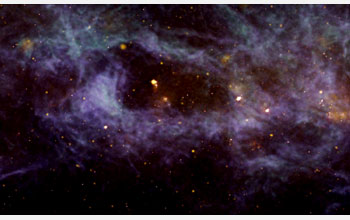Multimedia Gallery
Majestic Gas Shell
A majestic gas shell revealed by the Very Large Array (VLA), a collection of 27 radio antennas located at the National Radio Astronomy Observatories (NRAO) site in Socorro, N.M. What appears to be the hole of an elongated smoke ring in this image is really an enormous, nearly empty, bubble blown into the dusty gas disk of our Milky Way galaxy.
More about this Image
Interstellar bubbles like the one pictured here are sculpted by the force of the wind and radiation from, typically, a few dozen hot massive stars, along with the explosive impact of dying stars called supernovae. The force sweeps up the disk's gas that is in its path, creating a gas shell surrounding a bubble. The neighborhood of our own solar system resides in such a cavity. However the shell in this image, catalogued using its coordinates as galactic shell GS 62.1+0.2-18, is located at a distance of 30,000 light years from Earth and measures 1,100 by 520 light years.
Despite its distance, this "smoke ring" appears so large on the sky that the apparent width of the full moon would fit eight times inside it. The bright yellowish-orange dots scattered across the image are clusters of young, massive stars surrounded by hot gas, called nebulae. Astronomers from the International/VLA Galactic Plane Survey have determined that none of these clusters harbor the stars that blew the giant shell since none of the clusters are at the same distance as the shell. Indeed, they all are located closer to the Earth than the shell is. Probably, the stars that blew GS 62.1+0.2-18's hole perished as supernova explosions. This image shows only a small part of a survey that uses both VLA and the Green Bank Telescope to trace in detail, the cool gas in our galaxy. This gas has been colored purple, blue and green in this image. In order to show the locations of star clusters, the image of gas was overlaid with two additional images. The one of radio emission associated with regions of hot gas was colored orange, while heated dust, imaged in infrared by the Midcourse Space Experiment satellite, was colored red. [The principal investigator for the survey is A. R. Taylor. This study is published by VGPS investigators J.M. Stil, A.R. Taylor, J.M. Dickey, D.W. Kavars, P.G. Martin, T.A. Rothwell, A.I. Boothroyd, Felix J. Lockman and N.M. McClure-Griffiths in the Astronomical Journal, Volume 132, number 3, page 1158.] (Date of Image: unknown)
Credit: Image courtesy of NRAO/AUI and Jayanne English (U. Manitoba), Jeroen Stil and Russ Taylor (U. Calgary) and MSX
See other images like this on your iPhone or iPad download NSF Science Zone on the Apple App Store.
Special Restrictions:
This image is approved for personal use only by the National Radio Astronomy Observatory. If you wish to use this image for any other purpose, please read the NRAO Image Use Policy.
Use of NRAO/AUI names and/or logos in publicity, promotional or advertising is prohibited without prior written consent of NRAO/AUI. Commercial use will be considered on a case-by-case basis.
Images and other media in the National Science Foundation Multimedia Gallery are available for use in print and electronic material by NSF employees, members of the media, university staff, teachers and the general public. All media in the gallery are intended for personal, educational and nonprofit/non-commercial use only.
Images credited to the National Science Foundation, a federal agency, are in the public domain. The images were created by employees of the United States Government as part of their official duties or prepared by contractors as "works for hire" for NSF. You may freely use NSF-credited images and, at your discretion, credit NSF with a "Courtesy: National Science Foundation" notation.
Additional information about general usage can be found in Conditions.
Also Available:
Download the high-resolution JPG version of the image. (446 KB)
Use your mouse to right-click (Mac users may need to Ctrl-click) the link above and choose the option that will save the file or target to your computer.



